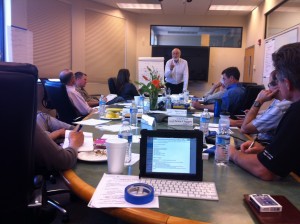 This week our two Tucson Vistage CEO groups hosted author, speaker and trainer Abe Wagner speaking on Increasing Motivation and Productivity. Wagner’s presentation is based on a foundation of Transactional Analysis and Neurolinguistic Programming. In 3 hours he presented and demonstrated tools that, with a little practice can be used to build rapport as a solid basis for difficult conversations with clients, employees or family members. Among the many topics he covered was the concept of channels: visual, auditory and kinesthetic. We learned that practically all of us rely on a mixture of all three, and that all of us also have a preferential channel–one that we will go to in times of stress.
This week our two Tucson Vistage CEO groups hosted author, speaker and trainer Abe Wagner speaking on Increasing Motivation and Productivity. Wagner’s presentation is based on a foundation of Transactional Analysis and Neurolinguistic Programming. In 3 hours he presented and demonstrated tools that, with a little practice can be used to build rapport as a solid basis for difficult conversations with clients, employees or family members. Among the many topics he covered was the concept of channels: visual, auditory and kinesthetic. We learned that practically all of us rely on a mixture of all three, and that all of us also have a preferential channel–one that we will go to in times of stress.
Why is that important? When communicating with others and attempting to first build rapport one technique for reaching rapport quickly is identifying and matching the preferential channel of the other person.
Wagner, author of Say It Straight or You’ll Show It Crooked, and The Transactional Manager identified seven techniques that focus on one particular approach he calls The Map of The World. In essence, these are techniques to help see the situation from the perspective of the other. They are:
- Paraphrase
- Check and Paraphrase
- Asking Questions
- Brief Responses
- Making Sounds
- Non Verbal Clues and
- Touching.
Much of this is framed in Wagner’s model of Ego States. These states are interesting in that some are constructive and some quite the opposite. They include:
- The Nurturing Parent
- The Critical Parent
- The Adult
- The Natural Child
- The Defiant Child
Most of us move in and out of these states regularly. Some spend more time in the destructive states than others. The key according to Wagner is to respond to attack, defiance, and aggression from one of the “blue states,” those being the Adult, Nurturing Parent or Defiant Child.
Wagner is typical of our great Vistage speakers who present information founded in solid, analytical theory who are able to distill that theory down into usable, practical techniques and models. If you’d been in one of these two meetings you’d be much better equipped to deal with the world than you were on Monday. Find much more information in either of his two books.
